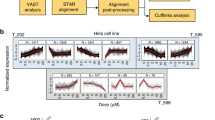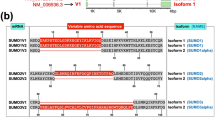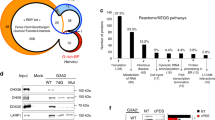Abstract
In response to oncogenic signals, Alternative Splicing (AS) regulators such as SR and hnRNP proteins show altered expression levels, subnuclear distribution and/or post-translational modification status, but the link between signals and these changes remains unknown. Here, we report that a cytosolic scaffold protein, IQGAP1, performs this task in response to heat-induced signals. We show that in gastric cancer cells, a nuclear pool of IQGAP1 acts as a tethering module for a group of spliceosome components, including hnRNPM, a splicing factor critical for the response of the spliceosome to heat-shock. IQGAP1 controls hnRNPM’s sumoylation, subnuclear localisation and the relevant response of the AS machinery to heat-induced stress. Genome-wide analyses reveal that IQGAP1 and hnRNPM co-regulate the AS of a cell cycle-related RNA regulon in gastric cancer cells, thus favouring the accelerated proliferation phenotype of gastric cancer cells. Overall, we reveal a missing link between stress signals and AS regulation.
This is a preview of subscription content, access via your institution
Access options
Subscribe to this journal
Receive 50 print issues and online access
$259.00 per year
only $5.18 per issue
Buy this article
- Purchase on Springer Link
- Instant access to full article PDF
Prices may be subject to local taxes which are calculated during checkout








Similar content being viewed by others
References
Pan Q, Shai O, Lee LJ, Frey BJ, Blencowe BJ. Deep surveying of alternative splicing complexity in the human transcriptome by high-throughput sequencing. Nat Genet. 2008;40:1413–5. http://www.nature.com/ng/journal/v40/n12/abs/ng.259.html.
Wang Z, Burge CB. Splicing regulation: From a parts list of regulatory elements to an integrated splicing code. RNA. 2008;14:802–13. http://rnajournal.cshlp.org/content/14/5/802.
Oltean S, Bates DO. Hallmarks of alternative splicing in cancer. Oncogene. 2014;33:5311–8. https://www.nature.com/articles/onc2013533.
Sveen A, Kilpinen S, Ruusulehto A, Lothe RA, Skotheim RI. Aberrant RNA splicing in cancer; expression changes and driver mutations of splicing factor genes. Oncogene. 2016;35:2413–27. https://www.nature.com/articles/onc2015318.
El Marabti E, Younis I. The cancer spliceome: reprograming of alternative splicing in cancer. Front Mol Biosci. 2018;5. https://www.ncbi.nlm.nih.gov/pmc/articles/PMC6137424/.
Kahles A, Lehmann K-V, Toussaint NC, Hüser M, Stark SG, Sachsenberg T, et al. Comprehensive analysis of alternative splicing across tumors from 8,705 patients. Cancer Cell. 2018;34:211-224.e6. http://www.sciencedirect.com/science/article/pii/S1535610818303064.
Cherry S, Lynch KW. Alternative splicing and cancer: insights, opportunities, and challenges from an expanding view of the transcriptome. Genes Dev. 2020;34:1005–16. http://genesdev.cshlp.org/content/34/15-16/1005.
Langeberg LK, Scott JD. Signalling scaffolds and local organization of cellular behaviour. Nat Rev Mol Cell Biol. 2015;16:232–44. https://www.ncbi.nlm.nih.gov/pmc/articles/PMC4722875/.
Rosenbaum JC, Fredrickson EK, Oeser ML, Garrett-Engele CM, Locke MN, Richardson LA, et al. Disorder targets misorder in nuclear quality control degradation: a disordered ubiquitin ligase directly recognizes its misfolded substrates. Mol Cell. 2011;41:93–106.
Suganuma T, Mushegian A, Swanson SK, Abmayr SM, Florens L, Washburn MP, et al. The ATAC acetyltransferase complex coordinates MAP kinases to regulate JNK target genes. Cell 2010;142:726–36.
Rappsilber J, Ryder U, Lamond AI, Mann M. Large-scale proteomic analysis of the human spliceosome. Genome Res. 2002;12:1231–45. https://www.ncbi.nlm.nih.gov/pmc/articles/PMC186633/.
Llères D, Denegri M, Biggiogera M, Ajuh P, Lamond AI. Direct interaction between hnRNP-M and CDC5L/PLRG1 proteins affects alternative splice site choice. EMBO Rep. 2010;11:445–51. Jun
Johnson M, Sharma M, Brocardo MG, Henderson BR. IQGAP1 translocates to the nucleus in early S-phase and contributes to cell cycle progression after DNA replication arrest. Int J Biochem Cell Biol. 2011;43:65–73.
Smith JM, Hedman AC, Sacks DB. IQGAPs choreograph cellular signaling from the membrane to the nucleus. Trends Cell Biol. 2015;25:171–84. https://www.ncbi.nlm.nih.gov/pmc/articles/PMC4344846/.
Sayedyahossein S, Li Z, Hedman AC, Morgan CJ, Sacks DB. IQGAP1 binds to yes-associated protein (YAP) and modulates its transcriptional activity. J Biol Chem. 2016;291:19261–73.
Lamm N, Read MN, Nobis M, Van Ly D, Page SG, Masamsetti VP, et al. Nuclear F-actin counteracts nuclear deformation and promotes fork repair during replication stress. Nat Cell Biol. 2020;22:1460–70. https://www.nature.com/articles/s41556-020-00605-6.
White CD, Brown MD, Sacks DB. IQGAPs in cancer: A family of scaffold proteins underlying tumorigenesis. FEBS Lett. 2009;583:1817–24. http://www.sciencedirect.com/science/article/pii/S0014579309003731.
Osman MA, Sarkar FH, Rodriguez-Boulan E. A molecular rheostat at the interface of cancer and diabetes. Biochim Biophys Acta. 2013;1836:166–76.
Hu W, Wang Z, Zhang S, Lu X, Wu J, Yu K, et al. IQGAP1 promotes pancreatic cancer progression and epithelial-mesenchymal transition (EMT) through Wnt/β-catenin signaling. Sci Rep. 2019;9:7539.
Liu J, Ni X, Li Y, Chen M, Chen W, Wu Y, et al. Downregulation of IQGAP1 inhibits epithelial-mesenchymal transition via the HIF1α/VEGF-A signaling pathway in gastric cancer. J Cell Biochem. 2019;120:15790–9.
Li S, Wang Q, Chakladar A, Bronson RT, Bernards A. Gastric hyperplasia in mice lacking the putative Cdc42 effector IQGAP1. Mol Cell Biol. 2000;20:697–701. http://mcb.asm.org/content/20/2/697.
Gattoni R, Mahé D, Mähl P, Fischer N, Mattei MG, Stévenin J, et al. The human hnRNP-M proteins: structure and relation with early heat shock-induced splicing arrest and chromosome mapping. Nucleic Acids Res. 1996;24:2535–42. https://www.ncbi.nlm.nih.gov/pmc/articles/PMC145970/.
Kafasla P, Patrinou-Georgoula M, Lewis JD, Guialis A. Association of the 72/74-kDa proteins, members of the heterogeneous nuclear ribonucleoprotein M group, with the pre-mRNA at early stages of spliceosome assembly. Biochem J. 2002;363:793–9.
Liebelt F, Sebastian RM, Moore CL, Mulder MPC, Ovaa H, Shoulders MD, et al. SUMOylation and the HSF1-regulated chaperone network converge to promote proteostasis in response to heat shock. Cell Rep. 2019;26:236-249.e4. http://www.sciencedirect.com/science/article/pii/S2211124718319570.
Tammsalu T, Matic I, Jaffray EG, Ibrahim AFM, Tatham MH, Hay RT. Proteome-wide identification of SUMO modification sites by mass spectrometry. Nat Protoc. 2015;10:1374–88. http://www.nature.com.gate2.inist.fr/nprot/journal/v10/n9/full/nprot.2015.095.html.
Hendriks IA, D’Souza RCJ, Yang B, Verlaan-de Vries M, Mann M, Vertegaal ACO. Uncovering global SUMOylation signaling networks in a site-specific manner. Nat Struct Mol Biol. 2014;21:927–36. https://www.nature.com/articles/nsmb.2890.
Hendriks IA, D’Souza RC, Chang J-G, Mann M, Vertegaal ACO. System-wide identification of wild-type SUMO-2 conjugation sites. Nat Commun. 2015;6:7289. https://www.nature.com/articles/ncomms8289.
Damianov A, Ying Y, Lin C-H, Lee J-A, Tran D, Vashisht AA, et al. Rbfox proteins regulate splicing as part of a large multiprotein complex LASR. Cell. 2016;165:606–19. https://www.cell.com/cell/abstract/S0092-8674(16)30338-5.
Irimia M, Weatheritt RJ, Ellis JD, Parikshak NN, Gonatopoulos-Pournatzis T, Babor M, et al. A highly conserved program of neuronal microexons is misregulated in autistic brains. Cell. 2014;159:1511–23. https://www.cell.com/cell/abstract/S0092-8674(14)01512-8.
Gohr A, Irimia M. Matt: Unix tools for alternative splicing analysis. Bioinformatics 2019;35:130–2.
Choi YD, Dreyfuss G. Isolation of the heterogeneous nuclear RNA-ribonucleoprotein complex (hnRNP): a unique supramolecular assembly. Proc Natl Acad Sci USA. 1984;81:7471–5.
Kafasla P, Patrinou-Georgoula M, Guialis A. The 72/74-kDa polypeptides of the 70-110 S large heterogeneous nuclear ribonucleoprotein complex (LH-nRNP) represent a discrete subset of the hnRNP M protein family. Biochem J. 2000;350:495–503.
Cvitkovic I, Jurica MS. Spliceosome database: a tool for tracking components of the spliceosome. Nucleic Acids Res 2013;41:D132–141.
Ho Y-D, Joyal JL, Li Z, Sacks DB. IQGAP1 integrates Ca2+/calmodulin and Cdc42 signaling. J Biol Chem. 1999;274:464–70. http://www.jbc.org/content/274/1/464.
Sharma S, Findlay GM, Bandukwala HS, Oberdoerffer S, Baust B, Li Z, et al. Dephosphorylation of the nuclear factor of activated T cells (NFAT) transcription factor is regulated by an RNA-protein scaffold complex. Proc Natl Acad Sci USA. 2011;108:11381–6. http://www.ncbi.nlm.nih.gov/pmc/articles/PMC3136327/.
Popp MW-L, Maquat LE. Organizing principles of mammalian nonsense-mediated mRNA decay. Annu Rev Genet. 2013;47:139–65.
Johnson MA, Sharma M, Mok MTS, Henderson BR. Stimulation of in vivo nuclear transport dynamics of actin and its co-factors IQGAP1 and Rac1 in response to DNA replication stress. Biochim Biophys Acta BBA—Mol Cell Res. 2013;1833:2334–47. http://www.sciencedirect.com/science/article/pii/S0167488913002255.
Zhong X-Y, Ding J-H, Adams JA, Ghosh G, Fu X-D. Regulation of SR protein phosphorylation and alternative splicing by modulating kinetic interactions of SRPK1 with molecular chaperones. Genes Dev. 2009;23:482–95. https://www.ncbi.nlm.nih.gov/pmc/articles/PMC2648651/.
van der Houven van Oordt W, Diaz-Meco MT, Lozano J, Krainer AR, Moscat J, Cáceres JF. The Mkk3/6-p38–signaling cascade alters the subcellular distribution of Hnrnp A1 and modulates alternative splicing regulation. J Cell Biol. 2000;149:307–16. https://www.ncbi.nlm.nih.gov/pmc/articles/PMC2175157/.
Heyd F, Lynch KW. Degrade, move, regroup: signaling control of splicing proteins. Trends Biochem Sci. 2011;36:397–404.
Passacantilli I, Frisone P, De Paola E, Fidaleo M, Paronetto MP. hnRNPM guides an alternative splicing program in response to inhibition of the PI3K/AKT/mTOR pathway in Ewing sarcoma cells. Nucleic Acids Res. 2017;45:12270–84. https://www.ncbi.nlm.nih.gov/pmc/articles/PMC5716164/.
Mähl P, Lutz Y, Puvion E, Fuchs JP. Rapid effect of heat shock on two heterogeneous nuclear ribonucleoprotein-associated antigens in HeLa cells. J Cell Biol. 1989;109:1921–35.
Denegri M, Chiodi I, Corioni M, Cobianchi F, Riva S, Biamonti G. Stress-induced nuclear bodies are sites of accumulation of Pre-mRNA processing factors. Mol Biol Cell. 2001;12:3502–14. https://www.molbiolcell.org/doi/10.1091/mbc.12.11.3502.
Shalgi R, Hurt JA, Lindquist S, Burge CB. Widespread inhibition of posttranscriptional splicing shapes the cellular transcriptome following heat shock. Cell Rep. 2014;7:1362–70. http://www.sciencedirect.com/science/article/pii/S2211124714003465.
Meissner M, Dechat T, Gerner C, Grimm R, Foisner R, Sauermann G. Differential nuclear localization and nuclear matrix association of the splicing factors PSF and PTB. J Cell Biochem. 2000;76:559–66.
Marko M, Leichter M, Patrinou-Georgoula M, Guialis A. hnRNP M interacts with PSF and p54(nrb) and co-localizes within defined nuclear structures. Exp Cell Res. 2010;316:390–400.
Vertegaal ACO, Ogg SC, Jaffray E, Rodriguez MS, Hay RT, Andersen JS, et al. A proteomic study of SUMO-2 target proteins. J Biol Chem. 2004;279:33791–8. https://www.sciencedirect.com/science/article/pii/S0021925820774454.
Pozzi B, Bragado L, Will CL, Mammi P, Risso G, Urlaub H, et al. SUMO conjugation to spliceosomal proteins is required for efficient pre-mRNA splicing. Nucleic Acids Res. 2017;45:6729–45.
Hendriks IA, Vertegaal ACO. Label-free identification and quantification of SUMO target proteins. Methods Mol Biol. 2016;1475:171–93.
Hendriks IA, Lyon D, Young C, Jensen LJ, Vertegaal ACO, Nielsen ML. Site-specific mapping of the human SUMO proteome reveals co-modification with phosphorylation. Nat Struct Mol Biol. 2017;24:325–36. https://www.nature.com/articles/nsmb.3366.
Matic I, Schimmel J, Hendriks IA, van Santen MA, van de Rijke F, van Dam H, et al. Site-Specific Identification of SUMO-2 targets in cells reveals an inverted SUMOylation motif and a hydrophobic cluster SUMOylation motif. Mol Cell. 2010;39:641–52. http://www.sciencedirect.com/science/article/pii/S1097276510005733.
Kim YS, Keyser SGL, Schneekloth JS. Synthesis of 2′,3′,4′-trihydroxyflavone (2-D08), an inhibitor of protein sumoylation. Bioorg Med Chem Lett. 2014;24:1094–7. https://www.sciencedirect.com/science/article/pii/S0960894X14000298.
Van Nostrand EL, Pratt GA, Shishkin AA, Gelboin-Burkhart C, Fang MY, Sundararaman B, et al. Robust transcriptome-wide discovery of RNA-binding protein binding sites with enhanced CLIP (eCLIP). Nat Methods. 2016;13:508–14.
da Fonseca PCA, Kong EH, Zhang Z, Schreiber A, Williams MA, Morris EP, et al. Structures of APC/C(Cdh1) with substrates identify Cdh1 and Apc10 as the D-box co-receptor. Nature 2011;470:274–8.
Zhou Z, He M, Shah AA, Wan Y. Insights into APC/C: from cellular function to diseases and therapeutics. Cell Div. 2016;11:9.
Yamano H. APC/C: current understanding and future perspectives. F1000Research. 2019;8:8.
Engström Y, Eriksson S, Jildevik I, Skog S, Thelander L, Tribukait B. Cell cycle-dependent expression of mammalian ribonucleotide reductase. Differential regulation of the two subunits. J Biol Chem. 1985;260:9114–6. http://www.jbc.org/content/260/16/9114.
Alfieri C, Zhang S, Barford D. Visualizing the complex functions and mechanisms of the anaphase promoting complex/cyclosome (APC/C). Open Biol. 2017;7:170204.
Sherley JL, Kelly TJ. Regulation of human thymidine kinase during the cell cycle. J Biol Chem. 1988;263:8350–8.
Neumayer G, Belzil C, Gruss OJ, Nguyen MD. TPX2: of spindle assembly, DNA damage response, and cancer. Cell Mol Life Sci CMLS. 2014;71:3027–47. Aug
Biamonti G, Caceres JF. Cellular stress and RNA splicing. Trends Biochem Sci. 2009;34:146–53. http://www.sciencedirect.com/science/article/pii/S0968000409000061.
Vassileva MT, Matunis MJ. SUMO modification of heterogeneous nuclear ribonucleoproteins. Mol Cell Biol. 2004;24:3623–32. https://mcb.asm.org/content/24/9/3623.
Hendriks IA, Vertegaal ACO. A comprehensive compilation of SUMO proteomics. Nat Rev Mol Cell Biol. 2016;17:581–95. https://www.nature.com/articles/nrm.2016.81.
Liang Z, Yang Y, He Y, Yang P, Wang X, He G, et al. SUMOylation of IQGAP1 promotes the development of colorectal cancer. Cancer Lett. 2017;411:90–9. https://www.sciencedirect.com/science/article/pii/S0304383517306079.
Lian AT, Hains PG, Sarcevic B, Robinson PJ, Chircop M. IQGAP1 is associated with nuclear envelope reformation and completion of abscission. Cell Cycle. 2015;14:2058–74. http://www.ncbi.nlm.nih.gov/pmc/articles/PMC4613854/.
Santos A, Wernersson R, Jensen LJ. Cyclebase 3.0: a multi-organism database on cell-cycle regulation and phenotypes. Nucleic Acids Res. 2015;43:D1140–4. https://academic.oup.com/nar/article/43/D1/D1140/2437426.
Penas C, Ramachandran V, Ayad NG. The APC/C Ubiquitin Ligase: From Cell Biology to Tumorigenesis. Front Oncol. 2011;1:60.
McQuin C, Goodman A, Chernyshev V, Kamentsky L, Cimini BA, Karhohs KW, et al. CellProfiler 3.0: Next-generation image processing for biology. PLOS Biol. 2018;16:e2005970. https://journals.plos.org/plosbiology/article?id=10.1371/journal.pbio.2005970.
Saraiva-Agostinho N, Barbosa-Morais NL. psichomics: graphical application for alternative splicing quantification and analysis. Nucleic Acids Res. 2019;47:e7. https://doi.org/10.1093/nar/gky888.
Huelga SC, Vu AQ, Arnold JD, Liang TY, Liu PP, Yan BY, et al. Integrative genome-wide analysis reveals cooperative regulation of alternative splicing by hnRNP proteins. Cell Rep. 2012;1:167–78. http://www.cell.com/article/S2211124712000435/abstract.
Rando OJ, Zhao K, Crabtree GR. Searching for a function for nuclear actin. Trends Cell Biol. 2000;10:92–7. https://www.cell.com/trends/cell-biology/abstract/S0962-8924(99)01713-4.
Perez-Riverol Y, Csordas A, Bai J, Bernal-Llinares M, Hewapathirana S, Kundu DJ, et al. The PRIDE database and related tools and resources in 2019: improving support for quantification data. Nucleic Acids Res. 2019;47:D442–50.
Acknowledgements
We thank N. Boni-Kazantzidou and G.-R. Manikas for the generation of crucial preliminary data; P. Hantzis, M. Fousteri, V. Koliaraki (IFBR, B.S.R.C. “Al. Fleming”) and N. Balatsos (University of Thessaly, Greece) for cell lines and reagents; D. Black and A. Damianov (UCLA, USA) for plasmids and technical advice on minigene reporter splicing assays; A. Guialis (N.H.R.F., Athens, Greece) for antibodies and reagents; Per Haberkant and the EMBL Proteomics Core Facility for LC-MS/MS analyses and advice; Sofia Grammenoudi and the Flow cytometry facility of B.S.R.C. “Al. Fleming” for help with cell cycle analyses and discussions; Vladimir Benes, Jonathan Landry and the EMBL Genecore for RNA-seq analyses and discussions; Martina Samiotaki, George Stamatakis at the Proteomics Facility of B.S.R.C. “Al. Fleming” for LC-MS/MS analyses and discussions; the personnel of the Imaging facility of B.S.R.C. “Al. Fleming” for help with image acquisition. We also thank George Panayotou and Efthimios Skoulakis (B.S.R.C. “Al. Fleming”) for critical reading of the manuscript; Juan Valcarcel for help with the analysis of the RNA-seq data; Skarlatos G. Dedos (National and Kapodistrian University of Athens, Greece) for reagents, plasmids, discussions and critical reading of the manuscript.
Funding
InfrafrontierGR/Phenotypos Infrastructure, co-funded by Greece and the European Union (European Regional Development Fund) [NSRF 2014–2020, MIS 5002135]; Hellenic Foundation for Research & Innovation (HFRI) and the General Secretariat for Research and Technology (GSRT) [grant agreement 846 to ZE]; MR was supported by the European Research Council [ERC AdvG 670146]; European Commission Grant FP7-PEOPLE-2010-IEF [274837] to PK; Stavros Niarchos Foundation (SNF) donation to BSRC “Al. Fleming”.
Author information
Authors and Affiliations
Contributions
These authors contributed equally: Andrada-Maria Birladeanu, Malgorzata Rogalska, Myrto Potiri. AMB performed most of the immunofluorescence, subcellular fractionation, immunostaining and in vitro splicing experiments. M.R. performed all the statistical and bioinformatics analyses. MP performed the cellular assays (cell cycle, wound healing, colony formation, MTT assays) and CRISPR-Cas9 editing experiments. Z.E performed RT-PCR analyses and supervised AMB in in vitro splicing assays and MP in cell cycle analyses. VP performed immunofluorescence analyses, western blotting analyses, advised AMB. on image acquisition and analyses, supervised M.P. on cellular assays. MA and PK performed the xenograft experiments. DLK advised MA and helped with the cellular assays. JDL helped with the CRISPR-Cas9 editing experiments. PK conceived, designed and supervised the study, performed the immunoprecipitation experiments and wrote the manuscript. All authors edited and commented on the manuscript.
Corresponding author
Ethics declarations
Competing interests
The authors declare no competing interests.
Additional information
Publisher’s note Springer Nature remains neutral with regard to jurisdictional claims in published maps and institutional affiliations.
Supplementary information
Rights and permissions
About this article
Cite this article
Birladeanu, AM., Rogalska, M., Potiri, M. et al. The scaffold protein IQGAP1 links heat-induced stress signals to alternative splicing regulation in gastric cancer cells. Oncogene 40, 5518–5532 (2021). https://doi.org/10.1038/s41388-021-01963-7
Received:
Revised:
Accepted:
Published:
Issue Date:
DOI: https://doi.org/10.1038/s41388-021-01963-7
This article is cited by
-
Role of non-canonical post-translational modifications in gastrointestinal tumors
Cancer Cell International (2023)



